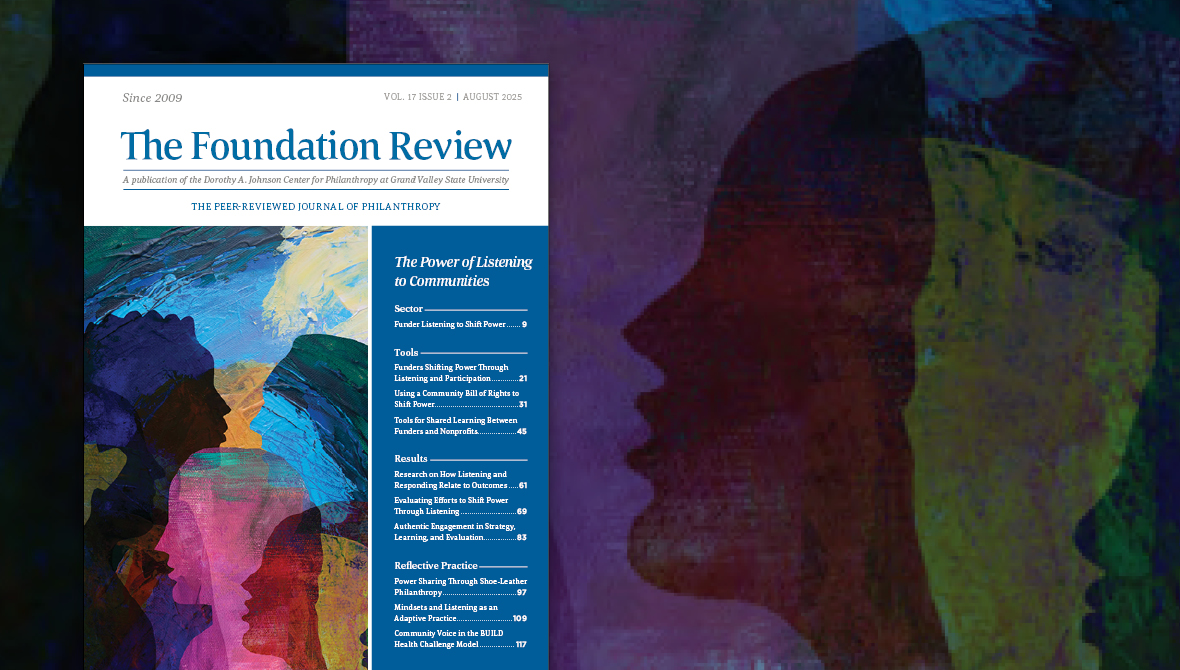The Power of Listening to Communities


Philanthropy has long positioned itself as an architect of social good, but the sector has often done this at a distance from the communities it serves. A new paradigm has emerged more recently, calling on funders to listen and respond to what communities say they want and need. This issue of The Foundation Review explores this paradigm in depth. It describes what funder listening is (and is not) and what happens when it is practiced with a clear purpose: shifting power to communities so they are partners in driving social change.
All articles in this issue share the core premise that all funder listening is not equally beneficial. How listening is defined and how funders put it into action make a major difference in what listening can accomplish.
This issue as a whole demonstrates that philanthropy must move from listening as transaction to listening as transformation. Foundations that embrace this challenge will not only hear more — they will learn more, evolve more, and, most importantly, improve their ability to achieve more.
Finally, this issue shows that the path forward is doable but not always easy or straightforward. Funder listening that shifts power asks funders to sit in the discomfort of vulnerability, to reconfigure roles and relationships, and to treat listening not as a tool, but as a way of being.


Julia Coffman
Editor-in-Chief
The Foundation Review
Are you interested in partnering with us on an upcoming issue of The Foundation Review? Let’s connect!
Most foundations say they listen, but all listening is not equally beneficial. Listening in ways that advance equity is done in partnership and requires a response from the listener to acknowledge what has been heard and what will happen as a result. This article outlines foundational principles and practices of funder listening to shift power, points to tools and resources that can support funders in different contexts, and invites funders to join a growing movement that respects the inherent expertise of communities.
Community-centered listening, combined with participatory processes, can help funders to shift from a “power over” orientation to interdependent relationships with community partners. In this article, two practitioners share how funder listening and community participation can help funders confront their own power while also honoring community agency. The article features case examples of funders on the path to shifting power through listening and participatory processes, and points to tools the authors developed and use regularly with funders.
Authors draw on their lived expertise and research to describe how even well-intentioned community engagement efforts can become extractive. As an alternative, they urge the use of a Community Bill of Rights to act as a guide for centering communities in philanthropic work. Drawing on case examples from healthcare, urban planning, and other fields, the authors call on philanthropy to use the Bill of Rights to ensure communities are treated as the primary owners of both process and outcomes.
Nonprofits have embraced community listening more rapidly than funders. This article leverages the experiences of Listen4Good, a long-term effort to support nonprofit organizations in listening and responding to the people they serve. The author, Listen4Good’s founder, offers concrete advice for funders and points to practical supports such as Listen4Good’s Best Practices framework and other tested tools and coaching protocols that can support philanthropy in getting equity-advancing feedback.
Six research teams tested the hypothesis that if direct-service organizations listen and respond to client feedback, then the likelihood of positive programmatic and client outcomes will increase. This article details research results and what they collectively say about the relationship between listening to participants and program effectiveness. This research has implications for how foundations select grantees, learn in partnership with them, and support their capacity to engage in effective listening.
The authors present findings from two evaluations that examined how participants perceived listening processes, including to what extent they felt heard and their perspectives on any resulting changes in power dynamics. Looking across these evaluation findings, the authors elevate ways of thinking about power and offer new considerations for funders listening to those most impacted by the problems they are working on.
Authors describe how the Irvine Foundation convened a subset of grantees to help shape the strategy and evaluation of a new statewide policy advocacy initiative. They explore what it takes to lean into the messiness of relational philanthropy and highlight (1) the reciprocal benefits of a generative and inclusive design, (2) how to cultivate authentic and trusting relationships, and (3) how to harness the collective power of grantees.
This article examines the Ruth Mott Foundation’s 15-year journey with community engagement in Flint, Michigan. Reflecting on the foundation’s model of “shoe-leather philanthropy,” authors describe the importance of shifting a foundation’s governance, giving priorities, staffing models, and operating practices to support effective community engagement practice.
Listening for equity requires that foundation leaders view the practice as adaptive and not merely technical. Listening without shifting values and beliefs can leave gaps between intention and action. In this article, the authors describe three mindsets and related practices foundations can use for authentic listening, using the Hartford Foundation for Public Giving as a case example.
The BUILD Health Challenge® (BUILD) is a funder collaborative that supports local cross-sector action to address the root causes of health inequities. BUILD funds partnerships that include residents, community-based organizations, health departments, and health systems. This article highlights BUILD’s listening process, how partners took action based on the feedback, and how long-term practice built trust and enabled transformative change.